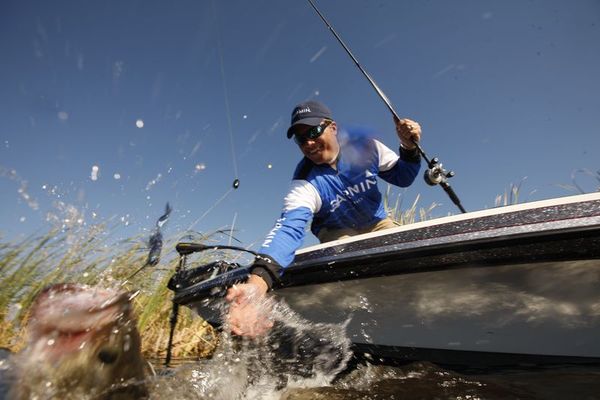Pro Tips with Scott Martin: Fishing Submerged Grass for Bass
Growing up at the big bass factory that Lake Okeechobee is and being the son of the Legendary Roland Martin, Scott Martin has perennially been one of the top anglers on the FLW Tour. We sat down and had a chat with the 2011 Forrest Wood Cup Champion to get some tips on something he knows very well – fishing grass in the springtime.
Garmin: Finding bass in expansive submerged grass flats can sometimes be like finding a needle in a haystack. How do you go about finding them?
Scott Martin: The first thing I do is look for bays with more spread out contour lines that go further out into the lake on my Garmin LakeVü HD Ultra mapping. From there, I’ll then look for little irregularities on those contours. A lot of times you can find submerged grass very far off from the shoreline. Next, look for flocks of American coots, which are duck-like birds that eat a lot of vegetation. If you see a lot of coots diving in the area, there’s a good chance you’ll find grass underneath them.
Garmin: How do your Garmin electronics help you find submerged grass and how do they help you fish it more efficiently?
Scott: Absolutely! When I’m looking for submerged vegetation that is not visible, I will utilize the Garmin SideVü technology and idle around with my units shooting out 100-120 ft. on each side of the boat. I’ll comb the area with my GPSMAP 1040xs, looking for individual grass beds or small submerged grass piles away from the bank. Once I locate those key areas, typically I’ll just fish them instead of idling directly over the top. It seems that in shallower water, if you idle over them with your big engine, you tend to spook them and shut down the bite, thus tricking you into thinking that there aren’t any fish there. When I find a small submerged grass bed using SideVü, I’ll take my cursor, scroll over to where it is and mark a waypoint on my graph. From there, I’ll put my trolling motor down and approach the waypoint, casting to the submerged grass bed undisturbed.
Garmin: What type of line do you use when fishing grass and why?
Scott: Typically when I’m flipping or using moving baits, such as a chatterbait or spinnerbait, I’ll use P-Line X-Braid. In heavy vegetation, the fish can’t see or just don’t pay attention to the braid, so you can get away with using it. When you’re casting, your lure is going much slower, so it gives the fish more time to see the bait and possibly notice the braid, so in that situation I opt to go with 20 lb. P-Line fluorocarbon.
Garmin: What are your go-to baits when fishing in and around grass?
Scott: For moving baits, I like chatterbaits, spinnerbaits, and weedless swimbaits. When casting and flipping, I use Texas rigged worms with a Trokar TK130 hook, which helps keep the bait extra weedless. As the grass gets closer to the surface and begins to mat, I will then start flipping it more and punching through the thick mats. As it grows even thicker, becoming one giant mat, then I will start throwing a frog.
Garmin: Thanks for taking the time to speak with us today and good luck on the rest of your season!
For the latest news and updates about Garmin fishing and hunting products follow us at @garminfishhunt on Twitter and Instagram, and on Facebook @Garmin Fish & Hunt, and tag us using #FishGarmin or #HuntGarmin.
The post Pro Tips with Scott Martin: Fishing Submerged Grass for Bass appeared first on Garmin Blog.
Sample Block Quote
Praesent vestibulum congue tellus at fringilla. Curabitur vitae semper sem, eu convallis est. Cras felis nunc commodo loremous convallis vitae interdum non nisl. Maecenas ac est sit amet augue pharetra convallis nec danos.
Sample Paragraph Text
Praesent vestibulum congue tellus at fringilla. Curabitur vitae semper sem, eu convallis est. Cras felis nunc commodo eu convallis vitae interdum non nisl. Maecenas ac est sit amet augue pharetra convallis nec danos dui.
Cras suscipit quam et turpis eleifend vitae malesuada magna congue. Damus id ullamcorper neque. Sed vitae mi a mi pretium aliquet ac sed elitos. Pellentesque nulla eros accumsan quis justo at tincidunt lobortis denimes loremous. Suspendisse vestibulum lectus in lectus volutpat, ut dapibus purus pulvinar. Vestibulum sit amet auctor ipsum.


